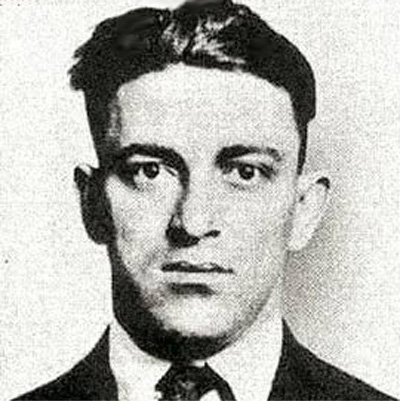
Earl "Hymie" Weiss (January 25, 1897 - October 11, 1926) was a American mobster who became a leader of the Prohibition-era North Side Gang and a bitter rival of Al Capone.
The $100 million a year Prohibition-fed criminal empire created by Johnny Torrio and Al Capone in Chicago between 1920 to 1931 was not without its serious challengers. The biggest threat to this massive organization was not from arrest or prosecution by police, the district attorney, or the city's elected officials (each of whom had numerous members on the Torrio-Capone payroll). Capone and Torrio faced their greatest challenge from a single rival: the Northsiders gang.
After Dean O'Banion's murder on November 10, 1924, Hymie Weiss took command of the North Side Gang and swore to avenge his friend's death. On January 24, 1925, Hymie and Bugs Moran ambushed Johnny Torrio outside his South Side home. Despite being badly wounded by pistol and shotgun fire, Torrio survived the attempt on his life.
The rival gangs squared off for war. Hymie Weiss and his pals were suspected of gunning down Sicilian crime boss Angelo Genna on May 26, 1925. The Gennas were longtime enemies of Dean O'Banion and were suspected of having a hand in his murder. Whether or not the North Siders actually killed him is still debated today.
After spending the better part of a year in jail, Hymie Weiss marshaled his men for a major strike on their rivals. On September 20, 1926, Al Capone was having lunch with bodyguard Frank Rio at the Hawthorne Hotel when a caravan of cars cruised past the Hawthorne Inn and riddled it hundreds of submachine gun bullets. According to some accounts, the second-to-last car stopped in front of the hotel where Capone was cowering. A gunman, clad in a khaki Army shirt and brown overalls, casually walked up to the hotel's front door and emptied a Thompson submachine gun into the room.
While Capone survived the attack, this act scared Al enough to a attempt a truce. At a peace conference on October 4, 1926, Hymie insisted that the trigger-pullers in the O'Banion murder (John Scalise and Albert Anselmi) be executed. Capone refused Weiss's terms and took more radical means to end the gang war.
Hymie Weiss was suspected of having formed an alliance with South Side beer baron Joe Saltis, who went on trial for murder in October 1926. It was widely rumored that Weiss would buy off the jury in order to ensure an acquittal for Saltis.
Jury selection began on October 11, 1926, and Hymie and four of his men were sighted there. At 4 o'clock that afternoon, Weiss and his pals left for their State Street headquarters, the old Schofield flower shop. Hymie Weiss and his men were crossing State to enter the shop when two gunmen hidden in a nearby rooming house opened fire with a submachine gun and shotgun. Weiss and bodyguard Paddy Murray were killed while the other three were wounded. Bullets from the fusillade chipped the cornerstone of the Holy Name Cathedral directly across the street.
Weiss was rumored to have left an estate worth $1.3 million dollars. Hymie's killers were never definitely identified, but Chicago Police suspected that the machine gunner may have been Jack McGurn. Rumor had it McGurn earned his nickname of "Machine Gun Jack" from the Weiss hit.
Weiss was said to have suffered from arterial cancer, which gave him blinding headaches, dizziness, and fainting spells. Often, he would relax on a couch on the second floor of the Schofield flower shop. Because of his illness, Hymie often said he didn't expect to live to an old age, which may explain his fearlessness in fighting his rivals. To this day, it is said that Hymie Weiss was the only man Al Capone was ever truly afraid of.